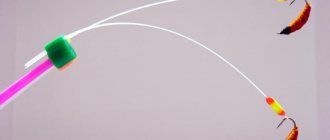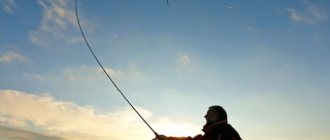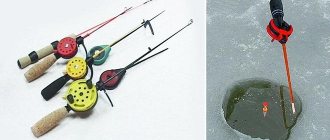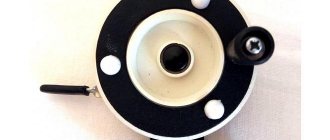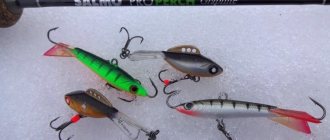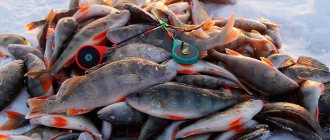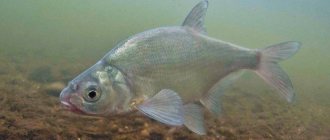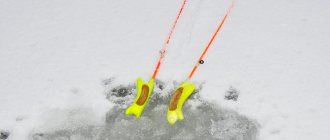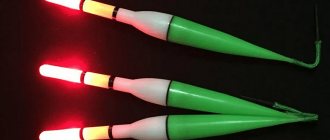Created: 07/01/2020
Updated: 07/07/2020 12:07:24Share:
*Review of the best according to the editors of expertology.ru. About the selection criteria. This material is subjective in nature, does not constitute advertising and does not serve as a purchase guide. Before purchasing, consultation with a specialist is required.
Float rods are simple and reliable equipment for fishing from the shore. Surely most experienced fishermen began their journey in this business with float rods. True, in this case we are talking about the so-called fly fishing rods, without guide rings and additional devices. Their antipode is Bolognese fishing rods. They are equipped with rings and a reel seat, and allow you to catch almost the entire variety of river fish with a float.
In this article, the editors of Expertology magazine selected the 9 best float rods in two categories. The criteria for selecting goods for the rating were:
- quality of workmanship and materials used;
- reliability of the design (number of rings/type of reel seat, quality of section articulation);
- price level;
- reviews from users and experts;
- ergonomic parameters (folded length, ease of use, etc.)
Types of fishing rods by purpose
The first thing the choice begins with is determining the purpose of the fishing rod. There are several types of the most popular gear:
- for winter fishing;
- fly rods;
- spinning rods;
- feeders;
- Bolognese fishing rods.
Each species must meet certain parameters to make it convenient to use it for fishing in reservoirs of different depths, widths, currents and vegetation, under different fishing conditions (in an ice hole, from a boat, from the shore, from a bridge, from a boat on the move), for specific fish.
Winter fishing rods (table of criteria):
| Criterion | Meaning |
| Build | hard |
| Test | 0 g (blood weight) |
| Length | 20 – 70 cm |
| Weight | very light 40 - 65 g |
| Type | single-arm, telescopic |
| Fish | mostly fish up to 1 kg (both predator and peaceful) |
Flying float rods (table of criteria):

| Criterion | Meaning |
| Build | fast and medium-fast up to 5 m, medium up to 7 m, slow up to 10 m |
| Test | 4 - 12 g proportional to length in meters |
| Length | 3 - 10 m, less often 11 m |
| Weight | optimally 100 - 250 g |
| Type | telescopic, plug-in |
| Fish | depends on the length of the blank and the action (from small to large peaceful fish, but with a landing net) |
Spinning rods (table of criteria):
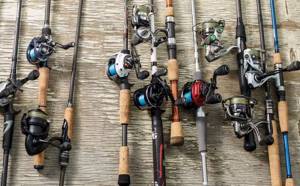
| Criterion | Meaning |
| Build | Fast (2.5 - 3 m), medium, slow |
| Test | 5 - 28 g |
| Length | 1.8 - 3.6 m |
| Weight | 100 - 300 g |
| Type | telescopic, plug-in |
| Fish | medium and large predator |
Feeders (criteria table):
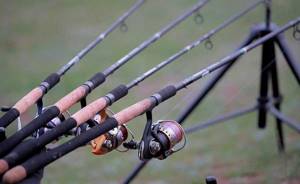
| Criterion | Meaning |
| Build | fast, medium, slow |
| Test | 100 - 200 g |
| Length | 2.7 - 4.2 m |
| Weight | 150 - 350 g |
| Type | telescopic, plug-in |
| Fish | mostly peaceful |
Bologna rods (table of criteria):
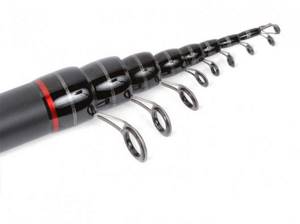
| Criterion | Meaning |
| Build | fast, medium-fast, medium |
| Test | 15 - 25 - 40 g |
| Length | 3 - 8 and more m |
| Weight | 150 - 350 g |
| Type | telescopic, plug-in |
| Fish | peaceful fish |
Summer float rods
The summer season is considered the most favorable for fishing, since most of the prey tries to stay close to the coastline and has a good appetite.
The choice of summer float rods largely depends on the type of intended prey; the main recommendations are given below:
- For catching crucian carp, it is recommended to use models with blind equipment , since they like to hide in dense underwater vegetation or reed thickets, where it is difficult to get to with other types of fishing rods.
- If the main prey is rudd or roach , then it is necessary to give preference to gear with an increased rod length. Light-weight fly rods that allow long casts are well suited for these purposes.
- When fishing for carp , especially small or medium-sized ones, it is preferable to use match rods.
Criterias of choice
First of all, you need to choose a fishing rod based on its intended purpose. That is, decide on which body of water and what kind of fish you will be fishing for. Catching a predator far from the shore - spinning, you need large fish that live in the river - it is better to take a feeder, fishing from a boat in still water - a fly rod or a winter side. All these gear have different parameters, which depend on the nature of fishing:
- length;
- system;
- test;
- type of knee connection;
- material;
- weight;
- shipping length;
- number of rings.
Length
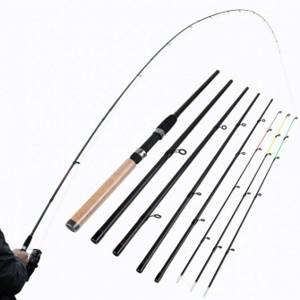
The working length of the rod depends on its purpose. On the fishing market there are models from 20 cm to 18 m. The smallest sizes are for winter fishing rods: a maximum of 70 cm. This is due to the lack of casting in ice fishing; the line is lowered directly into the hole.
Spinning rods and feeders are rarely longer than 3-4 m, because... with this type of fishing there is no need for a longer length: this is a mobile and sensitive tackle that has to be thrown often, especially for spinning rods. It will be difficult to constantly wave a long form. The casting distance is determined by the reel and fishing line with rings - the more optimal their selection, the easier it will be to cast the bait far.
The average fly rod has a length of 5, 6 and 7 m. This is the most convenient size. This length provides sufficient casting range for fishing from the shore or from a boat to shallow depths. The range is equal to the size of the rod. There are models up to 10 - 11 m, but these are used extremely rarely, mostly in competitions.
Bolognese fishing rods usually reach 5 - 8 m, but there are longer plug forms. This type of fishing rod is needed for fishing in the current and at great depths. The longer the rod, the more convenient it is to release the line and control the float and bites.
Build
Action is the degree of flexibility of the rod during bites and fishing. There are 3 main levels of structure and intermediate ones:
- very fast;
- fast;
- medium-fast;
- average (medium);
- medium-slow;
- slow
Fast action: the blank is rigid, only the upper end part bends. The average one leaves almost half of the rod stiff. And when the action is slow, the entire form up to the butt becomes flexible.
The choice of system does not have clear recommendations. Everyone's feelings are individual. “Col” or “noodle” - each fisherman has his own preferences, even for different types of fishing rods. For example, some people feel more comfortable with a hard spinning rod, but the feeder is completely soft. Based on reviews, you can’t choose a system, you can only test fishing rods to see which one will fit more comfortably in your hand. It is easier for beginners to start with a medium or medium-fast tuning, and then determine the choice based on experience.
Test

The test is the optimal weight of baits that can be used to load a fishing rod without loss of functional properties. Manufacturers sometimes inflate test scores to increase the versatility of their model. Each type of gear has its own test parameters for its intended purpose. The manufacturer writes the recommended weight of the bait in grams on the form. For beginners, it is advisable to stick to its average value.
They are distinguished by classes:
- ultra light or ultra light (UL): 0 - 7 g;
- light or light (L): 3 - 15 g;
- medium-light (ML): 5 - 25 g;
- medium (M): 10 - 30 g;
- medium-heavy (MH): 15 - 40 g;
- heavy (H): from 40 g.
Often, novice fishermen purchase models with a wide fork of dough, for example, 5 - 25 g. Experienced fishermen choose a rod with a certain value for their specific fishing style and proven baits, for example, from 1 g.
Type of elbow connection
The most common types of knee joints on the market are:
- telescopic;
- plug-in
“Telescopes” are cheaper, so they are more often found on budget fishing rods. Their disadvantage is that they are flimsy, the connections are insufficiently rigid, and over time they become loose and play.
Plug fishing rods are more expensive, but this connection of the knees is much more convenient, it turns out to be monolithic in feel. The plugs last a very long time. But not everyone can afford an analogue to a telescopic connection. The choice depends on the budget. If possible, it is better to immediately take a plug-in model.
Material

Nowadays fishing rods are made mainly from composite and carbon fiber. These materials meet the needs of fishermen for comfort and the modern nature of fishing: the tackle should be as light as possible, but remain strong and reliable, not afraid of dampness and other adverse effects, such as frost. Carbon is a high-modulus carbon fiber material that is much stronger and louder, which has a beneficial effect on the fisherman’s reaction to a bite, bottom topography, and bait play.
Carbon fishing rods are more expensive than composite ones. But lately their prices have differed several times, and cheap Chinese models are forcing brands to reduce prices. If you have a very limited budget, you can buy a composite fishing rod. If this is a model from a famous brand, then a beginner will definitely not notice a strong difference between the materials.
Weight
One of the most important points when choosing a fishing rod such as winter, fly, spinning or Bolognese is its weight. The smaller the weight of the model, the more convenient it is to fish, the less tired your arms and back are, and the more pleasure you get from the fishing process itself. The weight is less critical for feeders, because most of the time it stands on a stand. The weight of the rod is influenced by the materials of the components and the length of the product. The lightest ones are carbon gear. For experienced fishermen, a difference of even 50 g can be very noticeable.
Shipping length
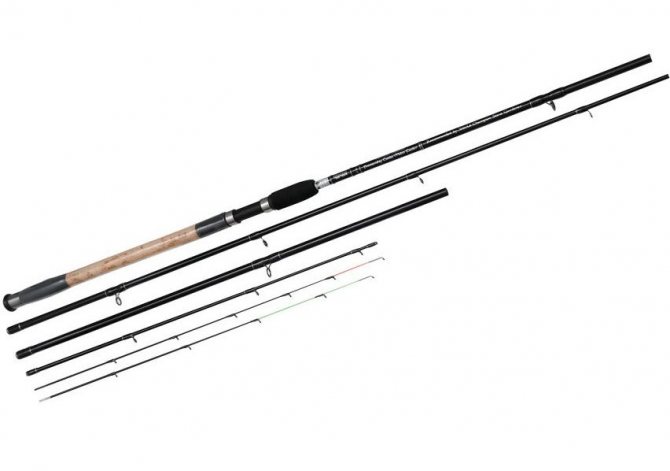
When choosing a model, it is important to think not only about the nature of the fishing, but also the place for fishing. If a body of water is within walking distance or there is a large SUV, then you can not pay attention to the transport length to which the tackle is folded. But for travel on public transport, for winter fishing, it is better to look for the shortest folded fishing rod. A winter fishing rod should ideally fit comfortably into a backpack.
Number of rings
The number of guide rings for fishing rods of different purposes, lengths and types of fishing is usually determined and is the same for most manufacturers. There are several rules regarding the number of rings:
- For longer lengths, more rings are placed;
- the higher the modularity, the fewer there are;
- Fewer rings are also installed on lightweight spinning rod models;
- for sensitive fishing (jigging), they are shifted to the end part;
- for trolling, the amount can increase by 1.5 - 2 times;
- When casting long distances, their diameter is more important than the number.
It’s easier for a beginner to trust the manufacturer in this matter. With the advent of experience and your own preferences, it is already worth listening to the reviews and advice of experienced fishing forums.
Types of float rods
Before you begin to study the available range and start choosing a fishing rod, you need to familiarize yourself with the main modern varieties.
Today, the following types of float fishing rods are distinguished:
- Rods with blind rigs are intended for experienced fishermen, as they are in demand when fishing in extremely difficult conditions when other gear is ineffective. In particular, they are used in reservoirs whose coastline is covered with dense vegetation. Such gear is completely devoid of a reel, which gives them such capabilities, eliminating the possibility of snags on a piece of fishing line located between the top of the fishing rod and this element of the equipment.
- Fly fishing rods are a common type of float tackle, which is closest in design to the previous option, since they also do not have a reel. The main distinguishing feature is the softness of the tuning. The tackle got its name due to the peculiarities of hand movements that the angler reproduces when making casts. This variety is recommended for use in open reservoirs, since in such conditions it will differ positively from other options by the ability to make targeted casts to the same place where an accumulation of prey was discovered.
- The English fishing rod is another common variety, which today is found in many modifications. Its design necessarily includes a coil, and absolutely any type of device is suitable. Fishing with such gear is usually carried out in areas of a reservoir with a rapid current, where wiring is required by analogy with spinning fishing.
- Match fishing rods are always equipped with a spinning reel type, and due to the ability to make the longest casts, these tackles are often used for fishing for trophy specimens. The main distinguishing features of such fishing rods are the following features: the use of exclusively sliding type floats, a length of up to 5 meters, increased flexibility and good sensitivity.
- Plug fishing rods are one of the recent inventions; the main advantage of this option is good mobility: when disassembled, the tackle is compact in size and does not take up much space, so it is quite easy to transport, which is especially important if it is not possible to get to the reservoir by personal transport. The essence of fishing is to gradually wear down the prey; at the same time, the angler must alternately disconnect the legs of the rod, bringing the fish closer and closer to the coastline. The process is quite simple, since special stands for fishing rods with a gear position lock and rollers are used for these purposes. All models of plug rods are equipped with shock absorbers, which are made of rubberized material and are built into the very top knee. This is necessary to ensure the ability to fish for large prey even despite the absence of a reel in the design, since the shock absorber suppresses the resistance of even the strongest fish.
The best rod for winter fishing
Salmo FIN (422-01)
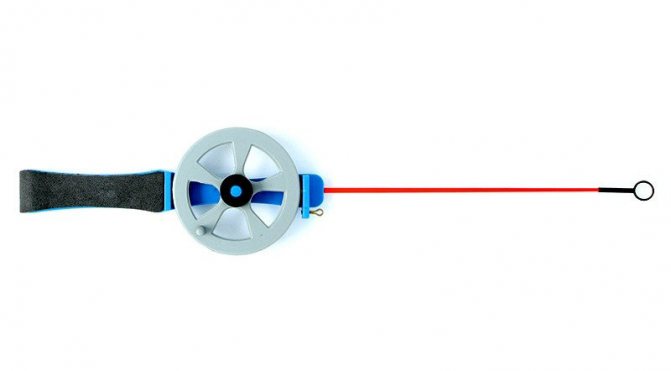
The combination of affordable prices, proven quality from a global brand and thoughtfulness of Scandinavian-type fishing rods makes the entire Fin line the favorites of winter fishing. The length of the single-legged whip of this model is 28 cm, convenient for small and medium depths, which is preferred by most lovers of sea fishing. Users note the versatility of the fishing rod for different types of bait: not only for spoons and balancers, but also for jigs or reelless baits. The open 5.5 cm reel rarely allows the line to run off thanks to the screw winding control mechanism. The neoprene ergonomic handle does not freeze and lies comfortably in the palm, resting with the butt on the wrist, which allows you to fish for fairly active and large fish. There is a steel ring at the end of the pole. In cold weather, all materials and parts behave well, everything is easily replaceable if necessary. The fishing rod is ideal for winter fishing and is accessible to every fisherman.
Advantages:
- inexpensive;
- reputable manufacturer;
- frost-resistant;
- quality materials;
- Scandinavian type;
- universal for various baits;
- reliable;
- stainless steel tulip;
- comfortable handle;
- 1 knee.
SIWEIDA ICE BEAR-65 2627003
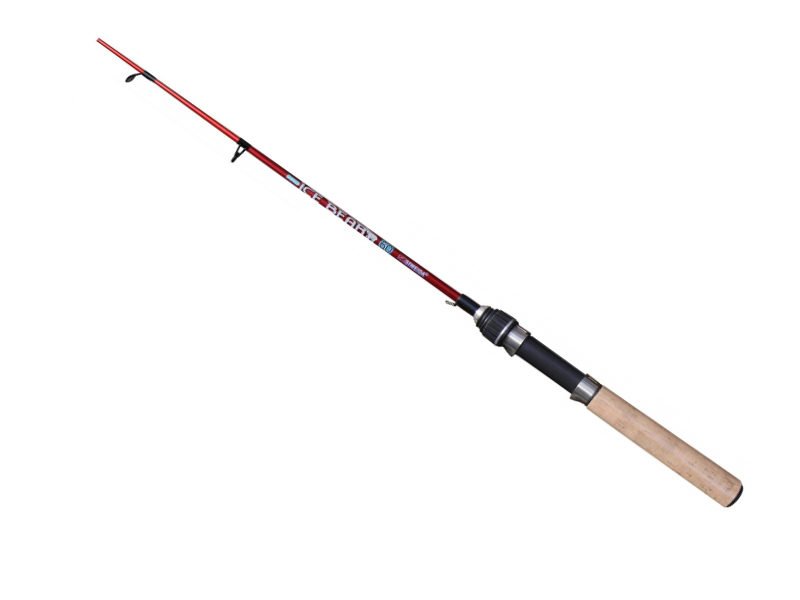
The telescopic fishing rod of the largest Chinese fishing brand is easy to transport: only 32 cm when folded, for fishing it unfolds to a maximum length of 65 cm. Suitable even for deep casting. This is the average whip size model in the Ice Bear line. The manufacturer took care of frost-resistant materials: a cork handle that is lightweight and prevents icing, and a plastic whip. The fishing rod has line guides and the ability to install a nod at the tip for a faster response to bites.
Advantages:
- variability in the length of the telescopic pole;
- factory China;
- ergonomic cork handle;
- lightweight but reliable;
- with rings;
- screw clutch;
- you can put a nod.
Flaws:
- a bit expensive for China;
- Over time it begins to play.
Rod materials
Float fishing rods can be made from various materials; today, according to this criterion, three main varieties are distinguished.
The features of each of them are discussed below:
- The very first fishing rods were made of wood ; bamboo or walnut were usually used for these purposes. Today, this option is outdated, but many fishermen still continue to use it; in most cases, such gear is homemade.
- Fiberglass is a more modern material ; its introduction into the gear production process has made it possible to launch mass production of telescopic fishing rods. Fishing rods made from this material are impressively heavy, but they have several significant advantages, including compact size, good mobility, a high level of precision in production and an impressive service life. All fiberglass models are equipped with guides and have special reel seats.
- Carbon is the most modern and high-quality material from which most fishing rods are made today. Using carbon fiber can significantly reduce the weight of the gear while simultaneously improving other characteristics. In particular, the degree of resistance to mechanical damage, strong bends and overloads of the rod increases. The sensitivity of the gear also changes in a positive direction, which allows the fisherman not to miss even the smallest bites.
The best feeder rod
Salmo Sniper FEEDER 90 3.60 (4013-360)
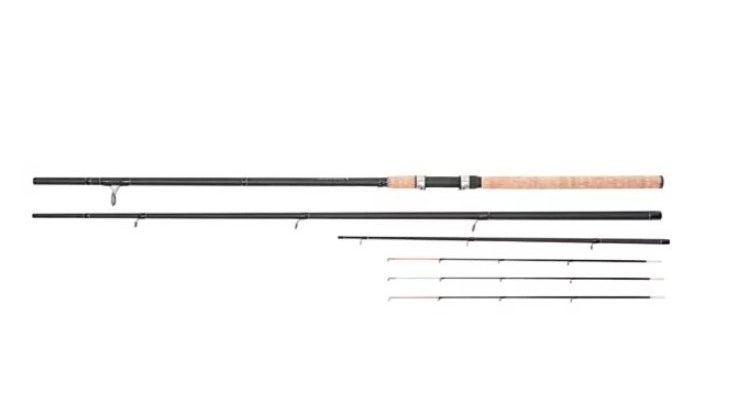
Salmo pleases with its entire line of feeders at an affordable price. The quality is excellent. Thanks to the composite, the form is light, flexible, and, compared to analogues in this price category, seems weightless in the hand. The rod is flexible and sensitive. Powerful and strong feeder for long casting. Catches large predators without problems. Convenient transport length of 1.3 m. 3 plugs are assembled at 3.6 m. There are ceramic rings and a set of 3 replaceable sensitive tips (there is not enough marking, but this is not critical).
Advantages:
- inexpensive;
- famous brand;
- easy;
- flexible;
- three-knee;
- easy to transport;
- suitable for long casting;
- for large fish;
- composite form;
- there are replaceable tips of different hardness;
- rings with ceramic inserts;
- cork handle.
Flaws:
- There are no markings on quivertypes, only signal coloring.
Kaida NeoXoen 3.9/60-120 (136-390)
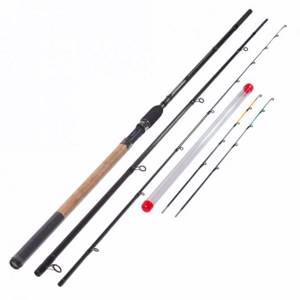
Manufacturer Kaida, known to demanding fishermen, presented a heavy class feeder line for universal carp fishing in various conditions: in a river with a current, or in still water. It features a lightweight and durable carbon fiber blank, flexible and highly sensitive to bites. Owners note overestimated strength indicators and classify it not as a heavy feeder, but as a medium feeder. A three-legged fishing rod, 3.9 m long, is only 1.2 m long during transportation. There are cases of it breaking at the butt, because could not withstand the load. The line has a screw reel seat and is reinforced in places of greatest tension with ceramic guide rings from Fuji. The lightweight cork handle is comfortable in the hand. Complete with a set of 3 interchangeable quivertypes and a case.
Advantages:
- manufacturer known for quality;
- very light and flexible feeder;
- greater sensitivity to bites;
- universal;
- easy to transport, because 1.2 m total;
- screw reel seat;
- carbon fiber blank;
- cork handle;
- good equipment;
- case;
- 3 interchangeable quivertypes.
Flaws:
- does not correspond to the stated parameters;
- in fact belongs to the middle class;
- There is a manufacturing defect when the feeder cracks at the butt.
Rod power
Power is another important parameter, the indicator of which depends primarily on the characteristics of the intended catch, but it must be taken into account that any fish when in the water weighs significantly less than after fishing on land.
Moreover, power is not in all cases determined by the length or weight of the selected model.
Some features of selection in accordance with this criterion are described below:
- Models belonging to the light class are designed for catching small fish with little weight. They are usually distinguished by a small rod diameter and are equipped with floats, the carrying capacity of which varies from 0.5 g to 1.5 g. For the most part, these are fly tackles without rings and with a length of no more than 4 meters, with a fast action and light equipment; such models are used by amateur fishermen only in rare cases.
- Models belonging to the middle class are the most versatile and common option. A wide range of modern models allows you to choose fishing rods with a length from 5 to 9 meters; the weight of the equipment thrown with such a fishing rod can range from 2 to 29g. This class includes a large number of different modifications; the correct choice will allow you to fish for prey weighing up to 10-12 kg.
- Models belonging to the heavy class are also quite common. Their impressive power ratings allow them to be used in bodies of water with the fastest currents or for fishing for trophy prey. When using such gear, you need to choose heavy equipment; the load capacity of the float should be at least 8 grams. In most cases, heavy class rods are used for paid fishing, if the prey is large carp or bream, as well as for catching catfish.
Above, three main groups of fishing rods were given in accordance with their power indicator, but today there are various systems that distinguish a different number of classes. In particular, there are ultra-light, medium-heavy, medium-light or super-heavy rod classes.
Belonging to a particular variety is determined by the maximum weight of the equipment that can be cast using a particular fishing rod.
The best fly rod
Black Hole Sparta 600
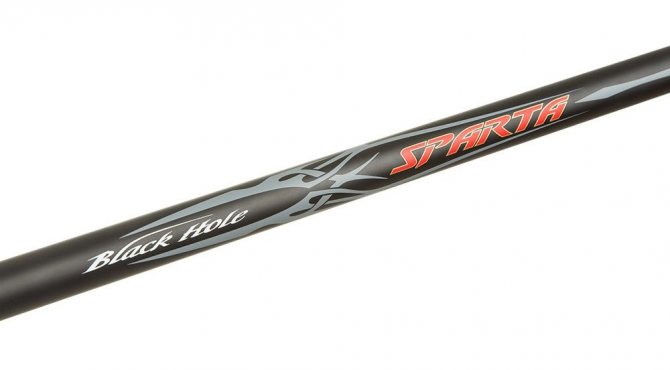
A line of universal fly rods from the Black Hole brand for float fishing both on the river and on standing reservoirs where you need to cast beyond the edge of the grass. The average form is 6 m, which consists of 6 sections. The walls of the knees are not thin, the assembly is reliable. Convenient for transportation, because gathers up to 1.3 m. Very easy swing, the hand will not get tired. The most advanced materials were used: carbon rod, rubberized anti-slip handle with notches. The swing is really elastic due to the lightness of the entire structure and high-quality assembly without backlash. Suitable for active fish, easy to fish because flexible blank absorbs jerks. It captivates not only with the quality of execution, but also with the cost, which is significantly lower than that of its analogues.
Advantages:
- value for money;
- accessible;
- reliable and easy swing;
- build quality;
- 6 elbows - 6 m, in transportation only 1.3 m;
- universal float rod;
- suitable even for large fish;
- carbon blank;
- anti-slip knurled handle fits comfortably in the hand;
- convenient to fish out.
Salmo Blaster POLE 500 (3123-500)
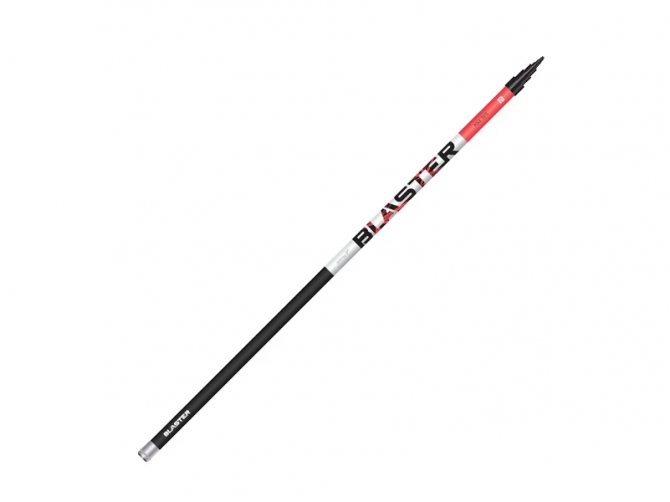
A good fly rod from a brand loved by anglers. For float fishing for crucian carp in small creeks, ponds and lakes. The working length of 5 elbows is 5 m, and the transport length is only 1.1 m. The swing is of medium action with a composite blank and a handle with comfortable anti-slip notches. This is a ready-made kit with a fishing line and a hook, you can immediately go fishing. It is advisable to place the connector on the holder ring or glue it, because not securely fastened.
Advantages:
- good producer;
- inexpensive fishing rod;
- folds up to 1.1 m;
- telescopic composite rod 5 m is assembled from 5 bends;
- handle with anti-slip notches;
- lightweight and flexible sensitive form;
- ready set.
Flaws:
- you need to secure the ring.
General principles for choosing a fishing rod
When choosing a float tackle, it is necessary to take into account not only the operating parameters described above, but also a number of additional factors.
Below are the main recommendations for this process:
- Any high-quality tackle must have an individual case designed for its dimensions and design features.
- It is necessary to pay attention to the patterns of graphite threads : their symmetry indicates a high level of quality.
- Rings must have a smooth surface structure and have an individual label containing detailed information about their manufacturer.
- where the rings are connected to the fishing rod require additional inspection
The best spinning rod
Black Hole Spy S-185/1-7

The entire line of spinning rods from this Korean brand pleases with an affordable price with high quality and thoughtful details (in this 2021 model there is an ergonomic reel seat with a nut, a spaced EVA handle that fits comfortably in the hand and does not slip). The main advantage of the SPY series spinning rods is a very durable but flexible blank that allows you to cast the bait absolutely accurately and quickly. The fast action, the strength of the rod, and the set of rings make the spinning rod universal for all types of lures. The fishing rod model was originally designed for chub fishing, but is also suitable for trout, especially aquaculture.
Advantages:
- global Korean brand;
- acceptable price;
- flexible and durable responsive form;
- two-knee, plug mount;
- casting accuracy;
- versatility for different baits;
- build fast;
- rod made of high modulus carbon;
- flexible tip does not break off;
- silicon carbide rings;
- optimal for ultralight;
- spaced handle;
- working length 1.85 m, transport length 0.96 m.
Salmo Sniper ULTRA SPIN 25 (2516-240)
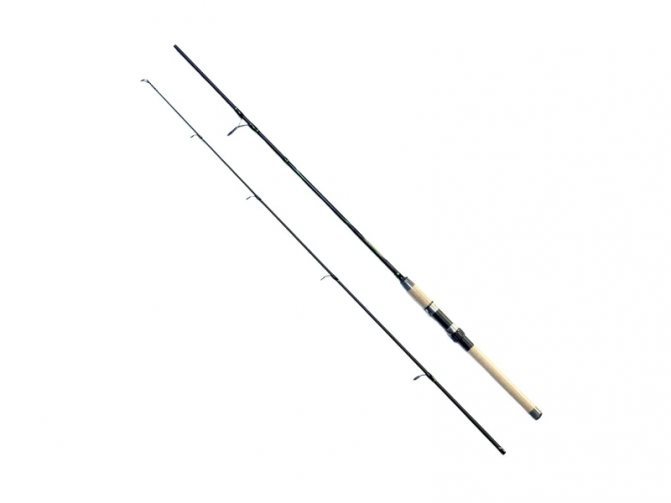
A very budget-friendly lightweight spinning rod, a little flimsy - the well-known manufacturer clearly saved on materials. Suitable more as a spare than a main fishing rod. The 2.4 m long plug rod is made of composite, the handle is cork, the action is stated to be medium. The test is too high, baits even weighing 15 g greatly strain the tip. There are reviews of strong cod when hatching large fish. If we take these shortcomings into account, it works well, is flexible, and casts accurately. Rings with ceramic inserts are arranged according to the classical pattern in places of greatest load, the tulip is wire.
Advantages:
- inexpensive;
- easy;
- flexible;
- accurate animation;
- composite form;
- handle made of Portuguese cork;
- rings with ceramics;
- two-piece plug rod.
Flaws:
- indicators are overestimated;
- rather weak for a large predator;
- cheap look.
Fishing rod equipment for summer fishing
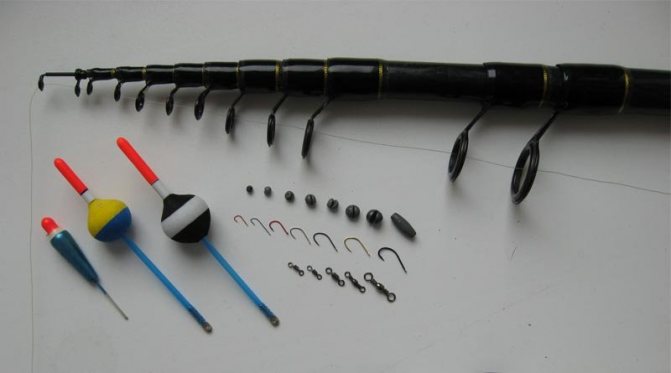
To catch large predatory fish, fishermen will need additional fishing rod equipment for summer fishing, since one rod will not be enough.
The equipment includes the following elements:
- Coil.
The size of the reel depends on the dimensions of the chosen fishing rod. For example, a float spinning rod requires size 1000. To catch fish with a feeder rod, you should focus on a 3000 reel size. You should also pay attention to the number of bearings. The more there are, the higher the probability of a good catch. - Hooks.
The choice of hooks depends on the type of bait used in the fishing process. Rods with a simple operating mechanism are equipped with hooks of sizes 5-9. For professional fishing rods, elements are selected individually. - Fishing line.
The size of the fishing line also depends on the type of spinning rod. If a fisherman plans to catch prey using a float structure, then a fishing line up to 0.22 mm thick is suitable. When fishing with spinning rods, you should focus on a thickness of 0.2 mm to 0.3 mm. The feeder requires a stronger fishing line with a thickness of 0.25 mm to 0.4 mm. - Float.
There are few criteria for choosing a float. You should focus on the rod that will be used for fishing. Fly rods require a lighter, gentler float. The match structure is equipped with heavy floats.
Spinning rods, in principle, do not need this detail. But for the feeder, the float is selected individually.
Fishermen should also pay attention to the choice of rings. Many experts advise sticking with titanium rings. For easy mining, ceramics are suitable.
The best Bolognese rod
MIKADO MATRIX 555 SUPER FLOAT 500
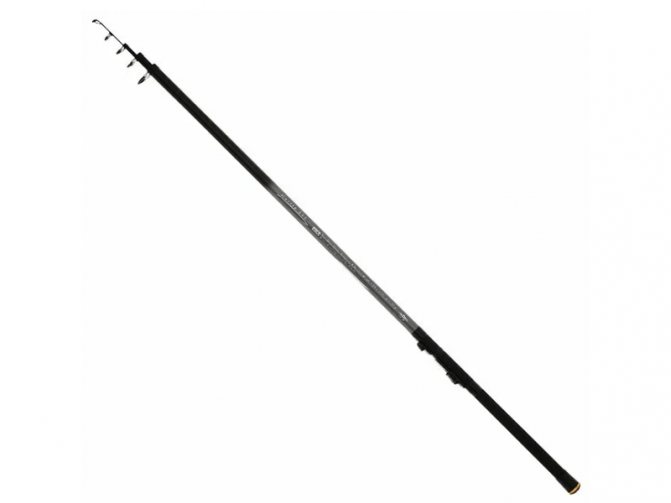
Excellent tackle from a renowned manufacturer. Float, telescopic form with classic rings. The working size is 5 m, and the transport size is only 1.2 m. The Bolognese fishing rod of medium action is suitable even for large fish. The test is stated to be up to 30 g, the blank is powerful, durable, made of carbon, and removes active predators. The handle is normal neoprene. The assembly and materials are of high quality, nothing plays or cracks.
Advantages:
- inexpensive;
- famous manufacturer;
- powerful and flexible form;
- carbon rod;
- standard “telescope” with rings;
- suitable for an active predator;
- baits weighing up to 30 g;
- bright design.
Salmo Elite BOLOGNESE MEDIUM M 600
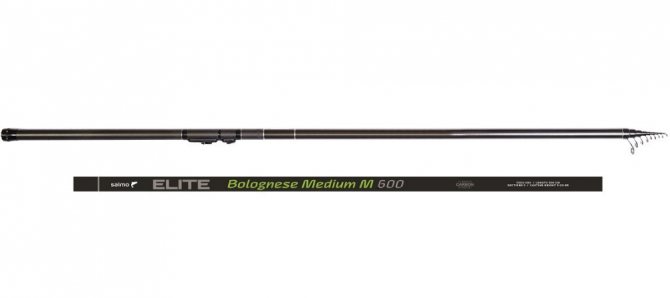
A light and comfortable rod, medium-fast action, long casting, thoughtful details - the Latvian brand has taken care of anglers who prefer to catch peaceful fish. Carbon fiber blank, handle with non-slip notches, lightweight classic rings with ceramics, plus 2 additional unloaders on the end bend. Clip up type reel seat. Telescopic 6 m rod when folded is 1.2 m, which is convenient for transportation. The lightness and sonority of the fishing rod is captivating. If you choose the right reel, you can easily fish by hand. Includes stand, case, and set of reel mounts. The rod is more soft than medium-hard. For small fish.
Advantages:
- very light for 6 m length;
- 2 additional rings will help reduce the load when fishing;
- sonorous carbon T30;
- anti-slip handle;
- good completeness;
- There is a cover (it used to be fabric, now it’s plastic).
Flaws:
- does not suit medium-hard tuning;
- for the Elite series the design is a bit rustic;
- Rings with ceramics are clearly unnecessary.
Rod size
The length of a float rod can be from 2 to 16 meters, but it must be taken into account that the largest models are quite difficult to handle and are intended for experienced fishermen who have certain skills and dexterity for this.
The choice of indicator also depends on the following factors:
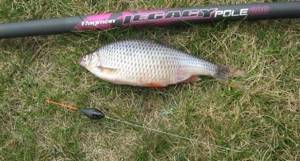
- The presence of any obstacles located on the coastline or underwater. The selected tackle should be of such length that you can cast over all existing obstacles.
- The estimated size and weight of the potential prey , since this determines its strength and the resistance it can provide.
- The total weight of all fishing rod equipment used.
- Distances from the angler’s location to the fishing point , since with a short rod it will not be possible to make the longest casts.
The best telescopic fishing rods
To conclude the material, we will give a rating of the most popular telescopic fishing rods, recommended for purchase or selection of a similar analogue.
- The leader in the ratings of telescopic gear is the flywheel model from Shimano, the legendary Catana EX TE 2-600 . An ultra-light, compact carbon fiber fishing rod with a test range of 5 to 10 grams that works in all weather conditions. Balanced tackle is capable of fighting large trophies, characterized by effective damping of overloads.
- Not far behind in popularity is the rod from Salmo - Sniper Pole Medium . The tackle is ideal for high-speed fishing at short distances, featuring a high sensitivity quiver tip, lightness and ergonomic handle. It is in the budget price range.
- The third on the list is the domestic fly fishing rod Sabaneev Master Pole 600 . It may be a little heavy, but the reliability of the rigid composite blank during dynamic fishing makes up for all the shortcomings with strength and confidence in catching the largest trophies. And the cost of the gear pleases with its affordable price.
- We give the fourth line to Atemi Classix Bolognese 6.0M . To a large extent, the high position of the model was assigned for the strength of the rod, which is recommended for a novice fisherman to master the technique of fishing with Bolognese tackle. In addition, the low price and skillfully made protective case will delight the fisherman who becomes the owner of this tool.
- Rounding out the top five is the stylish and practical tackle from Black Hole Atomic Bolo 700 . The high quality of workmanship and perfect balance of the seven-meter rod will please the experienced floater who knows a lot about Bolognese with comfortable fishing. The price of buying a masterpiece is a little constraining, but if you have the desire and perseverance, having acquired such a product, all you have to do is enjoy the fishing process, having a constant, stable catch.
Fly fishing rod
Some species of fish, such as trout, grayling, and chub, feed on the surface of reservoirs. In order to catch such fish, it is necessary to use very light baits that do not sink in the water. But, most importantly, you need to be able to keep the tackle on the surface of the water. To do this, anglers use the fly fishing method using fly fishing rods. With the help of the design of the fishing rod and its special equipment, the angler can count on a catch.
For beginner anglers, this gear may seem strange. A fly rod has a very short handle and the line reel is located below the handle. This design is unusual for anglers using classic types of fishing rods. A fly fishing rod consists of:
1. Form.
2. Coils.
3. Cord (which replaces fishing line).
4. Lures.
The raw materials for this fishing rod can be fiberglass, carbon fiber and bamboo. Glued bamboo is considered the optimal material. These fishing rods are handmade and have the ideal strength and reliability characteristics for fly fishing. Fly fishing rods are more suitable for experienced fishermen who have a certain amount of knowledge and practice. Beginners to fishing should not start their journey with fly fishing.
